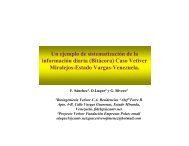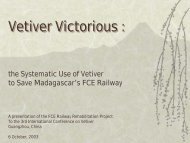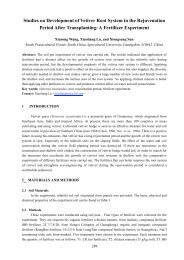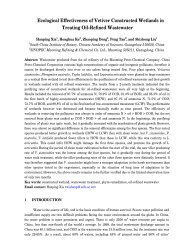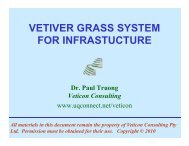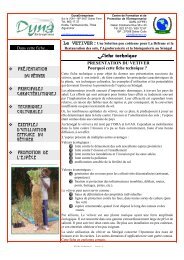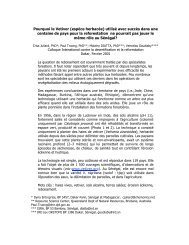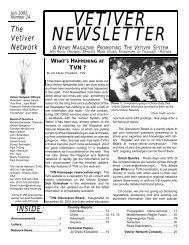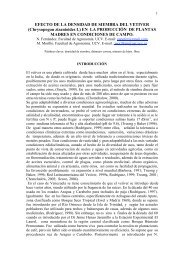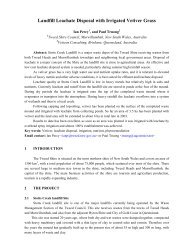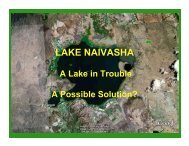Training manual - The Vetiver Network International
Training manual - The Vetiver Network International
Training manual - The Vetiver Network International
You also want an ePaper? Increase the reach of your titles
YUMPU automatically turns print PDFs into web optimized ePapers that Google loves.
2.4.1.1 Uses of <strong>Vetiver</strong>: Involves any direct exploitation of live vetiver plant such as<br />
for soil and water conservation, slope stabilization, erosion control, environmental protection, etc.<br />
without having to change or process the vetiver plant into finished or semi-finished products.<br />
Application of vetiver in agricultural and non-agricultural systems, first developed by the World<br />
Bank for soil and water conservation in the 1980s. It is one of the most effective and low cost<br />
natural methods of environmental protection deriving from its tolerance to adverse soil conditions<br />
and heavy metal toxicities, and phyremediation, as well as in erosion protection and slope<br />
stabilization.<br />
2.4.1.2 Utilization of <strong>Vetiver</strong>: Involves some kinds of processing of dead vetiver<br />
plants, including cut leaves, culms, roots, roots after essential oil extraction, etc. in the making roof<br />
thatch, for essential oil extraction, as a medium for mushroom growing, as raw material for<br />
handicraft making, as raw material for processing into industrial products (e.g. biodegradable<br />
nursery blocks or pots, construction materials, etc.). It does not include, however, the utilization of<br />
roots for essential oil extraction, since this requires the harvest of root mass which should be left in<br />
the ground to perform its main function in soil and water conservation.<br />
2.4.2. Agricultural Applications: Traditionally, vetiver has been used for soil and water<br />
conservation in India for 200 years before the <strong>Vetiver</strong> System has been popularized in recent years.<br />
<strong>The</strong> basis of soil erosion and acceptance of soil conservation measures will first be discussed (in<br />
Section 6.1) in order to help the trainees to understand the principle of soil erosion and its<br />
consequences. <strong>The</strong> use of vetiver in soil and water conservation, including soil erosion and<br />
sediment control on sloping land and flood plain, flood erosion control and slope stabilization, etc.,<br />
will then be discussed (in Section 6.2) followed by the works done by the Department of Land<br />
Development in northern Thailand on the use of vetiver in soil and water conservation in<br />
agricultural lands (in Section 6.3). <strong>The</strong> techniques of application of vetiver hedgerows on sloping<br />
farmlands will be discussed in Section 6.4 with demonstration of various apparatuses, to be held at<br />
the Chiang Rai Land Development Station during the study tour. Other benefits of growing vetiver<br />
like soil moisture conservation, watershed and catchment management, biological pest control,<br />
phytoremedial application, and trapping of agrochemical and nutrients will be discussed in Section<br />
6.5.<br />
2.4.3 Non-Agricultural Applications: It is undeniable that human activities are the main<br />
source of changes in the world geography and environment. Explicit examples of such acts include<br />
the explosion of mountains to build highways and railroads, drilling of mountains for mining,<br />
construction of dams across the rivers to build reservoirs, or the destruction of forest resources.<br />
Besides these, other causes include chemical changes in the atmospheres as a result of emission of<br />
gas or certain types of chemical substance, earthquakes, landslide and land subsidence, extinction of<br />
wild animal and plant species, as well as waves of extreme heat or drought which have occurred in<br />
several parts of the world. Undesirable and critical changes to the environment caused by man are<br />
now having impacts on human lives beyond control. Worst of all, one cannot anticipate the possible<br />
disastrous outcomes of this ongoing situation. Different methods including reliance of heavy<br />
machinery and cultivation of various crops have been attempted to resolve and prevent the problem.<br />
<strong>The</strong> use of vetiver in non-agricultural applications can be categorized as follows:<br />
2.4.3.1 Bioengineering (prevention mechanism): Bioengineering is defined as the use<br />
of organisms, mainly plants, on its own in integration with civil engineering works, to address the<br />
problems of erosion and slope stabilization. In this regard, vetiver can be employed in the<br />
followings:<br />
9



